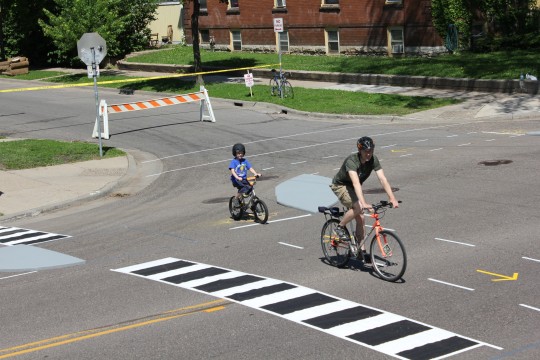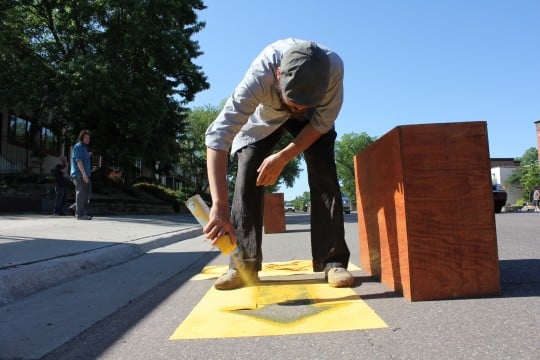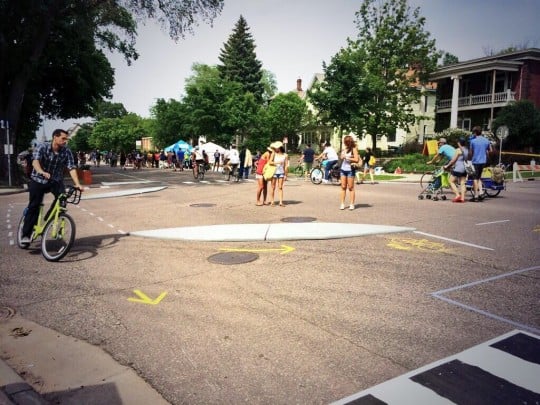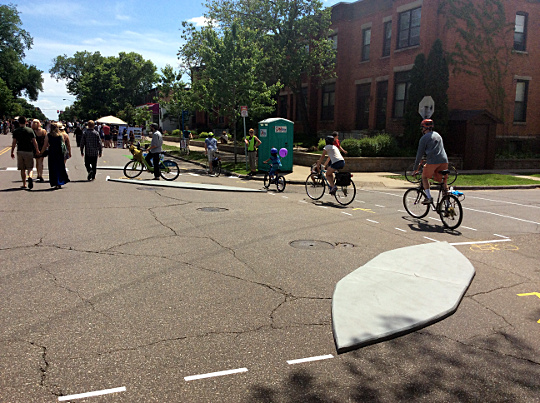
(Photos courtesy Alta Planning and Design)
A Portland planner’s concept for a way to almost completely eliminate bike-car conflicts from American intersections got its first road test in Minneapolis this month.
“Bikeways for Everyone,” a Blue Cross Blue Shield-funded, Minneapolis-based advocacy coalition with a goal to build 30 miles of protected bike lanes by 2020, invited Nick Falbo of Alta Planning and Design to create a one-day demo at Open Streets MPLS, the city’s version of Sunday Parkways.
It was a follow-up to the group’s pop-up protected bike lane, installed during last year’s Open Streets MPLS (and again this year) to introduce the concept of physically separated bike lanes to more ordinary riders.
This year, they invited Falbo to expand on a concept he started developing last fall and further honed over the winter: a riff on Dutch intersection design imagined in the context of large American streets with protected bike lanes.
As we shared on BikePortland in February, here are the four ingredients of Falbo’s design, which was first imagined for the corner of Southeast 122nd and Division:
Here’s how it might work for someone riding through one on a bicycle (follow the blue arrow):

By adding the eyelet-shaped curbs to the intersection, Falbo’s design shortens the crossing distance for bike traffic and puts right-turning drivers in a position where they can easily see a bike that’s crossing.
Here are some more shots of it in action in Minneapolis on June 8:
Advertisement
“I was really impressed with how children seemed to get it intuitively,” Falbo writes in an email. “They’d roll up through the intersection and just turn slightly to the left and sit in the protected area before crossing. I couldn’t imagine the same thing happening with more conventional designs.”
Falbo, who lives near 82nd Avenue in Southeast Portland, said he’d first hoped that the first demo could be in Portland.
I scanned the Portland Sunday Parkways maps for potential locations where it might be appropriate but unfortunately the routes are almost always on our neighborhood greenways. These streets are too small and not appropriate for the protected intersection design.
Lyndale Ave in Minneapolis was perfect. It was closed to cars as part the annual Minneapolis Open Streets events, and I jumped at the opportunity build a temporary installation. The street normally has 4 lanes and parking. By reallocating two of the travel lanes, we had plenty of room to create a 10 ft cycle track on each side of street, maintain on-street parking, and have room to maneuver around the corner refuge islands.
One important thing to understand about Falbo’s design (which was featured in Wired this morning!) is that it’s mostly theoretical. Falbo’s design presumes two major two-way streets that meet at right angles and both have one-direction bike lanes on each side.
As Portland Bicycle Planning Coordinator Roger Geller noted in an interview two weeks ago, that sort of intersection is pretty rare — and there aren’t yet any such corners in the United States where two protected bike lanes meet.
But that doesn’t mean the design isn’t useful. Two weeks ago, a Portland State University study found that although 96 percent of people who bike in protected bike lanes say they improve safety, between 15 and 37 percent of people feel unsafe at intersections where they have to merge with turning cars.
At an intersection that doesn’t force bikes and cars to merge, meanwhile, only 2 percent of people said they felt unsafe. In the long run, Falbo’s concept could be a great way to bring that sense of safety and comfort to more American streets.






